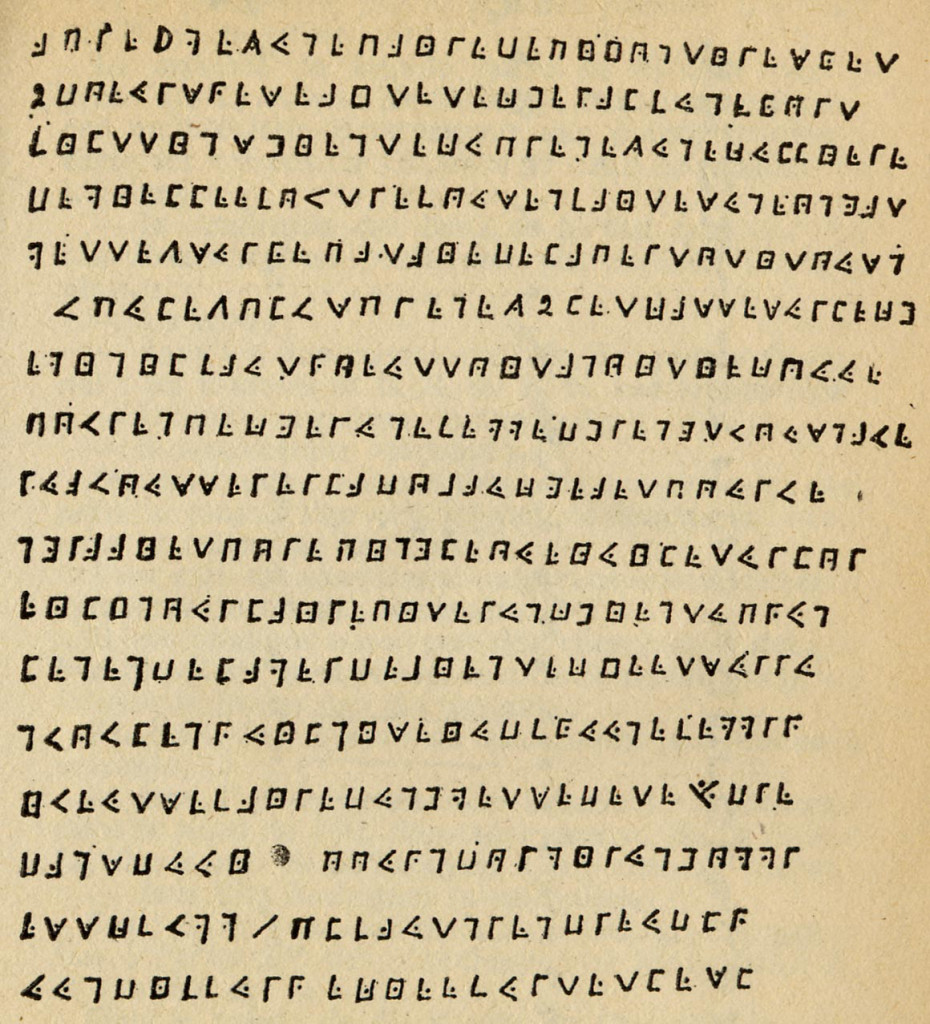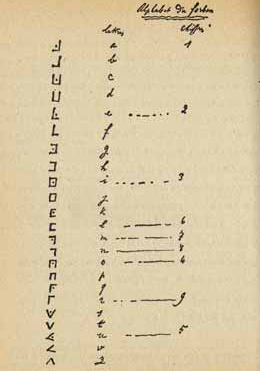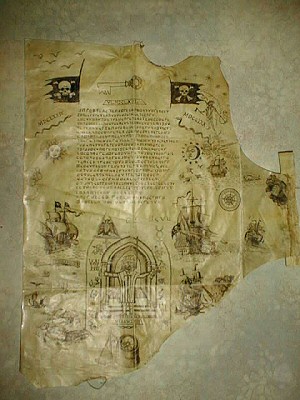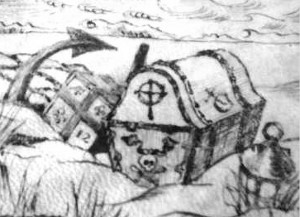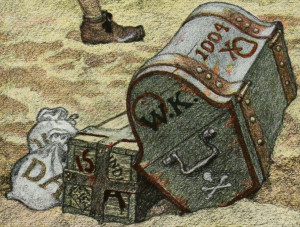Images of a cryptogram allegedly created by the 18th century pirate Olivier Levasseur (often called “La Buse”, the hawk) accompanied by sensational claims about hidden pirate booty have been circulating amongst the French treasure hunting community since at least 1934. This was when a book called “Le Flibustier Mysterieux” was published in Paris, written by well-respected French marine historian Charles Bourrel de la Roncière.
The 17-line cipher makes use of a popular set of cipher alphabet shapes known as a “pigpen cipher”:-
Cleverly, de la Roncière managed to decrypt this pigpen cipher without any difficulty…
…though it turned out that de la Roncière’s solid-looking decryption revealed what can only be described as a rather jumbled French cleartext. Here is one version of many that are floating around the Internet, with spaces guessed at to help make it a little more readable:-
[ 1] - aprè jmez une paire de pijon tiresket [ 2] - 2 doeurs sqeseaj tête cheral funekort [ 3] - filttinshientecu prenez une cullière [ 4] - de mielle ef ovtre fous en faites une ongat [ 5] - mettez sur ke patai de la pertotitousn [ 6] - vpulezolvs prenez 2 let cassé sur le che [ 7] - min il faut qoe ut toit a noitie couue [ 8] - povr en pecger une femme dhrengt vous n ave [ 9] - eua vous serer la dobaucfea et pour ve [10] - ngraai et por epingle oueiuileturlor [11] - eiljn our la ire piter un chien tupqun [12] - lenen de la mer de bien tecjeet sur ru [13] - nvovl en quilnise iudf kuue femm rq [14] - i veut se faire dun hmetsedete s/u dre [15] - dans duui ooun dormir un homm r [16] - esscfvmm / pl faut n rendre udlq [17] - u un diffur qecieefurtetlesl
Taken at face value, this plaintext would appear to have nothing at all to do with piracy or treasure or indeed Olivier Levasseur himself: rather, it looks much more like a scrambled (and multiply miscopied) recipe for a traditional folk remedy, or perhaps even a folk magic love spell.
All in all: to modern historians’ eyes, it remains highly unclear why a generally level-headed historian such as de la Roncière would publish a book about a cipher where the plaintext has been solved but reveals nothing, and where there is not one scrap of external evidence to link that cipher to a specific pirate.
Even so, this 17-line cryptogram seems genuine, even if its cleartext is extremely confused and its supposed link with La Buse (and indeed with pirate treasure at all) appears extremely spurious.
The Second Cryptogram
In recent years, images of a previously unknown second version of the cryptogram began appearing on the Internet:
Even though this contains broadly the same seventeen line cryptogram (though with a number of minor differences), it also has an additional five lines that were written using the same cipher system, which can be decrypted to read:
un bon verre dans l’hostel de l'évêque dant(S)
le siege du diable r(Q)uarar(N)te siz(X) degrés
f(S)iz(X) minutes deuz(X) fois
pour celui qui le decouvrira
juillet mil sept cent (T)rente
Elsewhere on the picture are the words “LA BUSE” (again enciphered using the same system), along with a drawing of a pirate (presumably La Buse) about to be hanged in front of a church (La Buse was taken to Réunion and hanged there for piracy on 7th July 1730), along with a number of pirate-style features – a copy of a map of the Caribbean, various pirate ships and prize ships, treasure, powder kegs, and numerous stylized details.
Problems with the Second Cryptogram
The immediate problem with the second cryptogram is that whereas the first seventeen lines are ambiguous and show numerous signs of miscopying and misinterpretation, the last five lines are almost exactly the opposite, in that they are models of clarity and straightforwardness.
A second major problem is that if you translate the last five lines into English…
a good drink in the bishop’s hostel in
the devil’s seat forty six degrees
six minutes two times
for the person who will discover it
july 1730
…and compare it with the cryptogram given by Edgar Allan Poe in his famous short story “The Gold Bug”, you find a particularly hard to explain parallel:-
A good glass in the bishop’s hostel in the devil’s seat
— forty-one degrees and thirteen minutes
— northeast and by north
— main branch seventh limb east side
— shoot from the left eye of the death’s-head
— a bee line from the tree through the shot fifty feet out.
Note that Poe later changed the second line to “twenty-one degrees and thirteen minutes”, so both 21 and 41 are correct.
Note also that Charles Baudelaire’s (1845) translation of the Gold Bug rendered this as “Un bon verre dans l’hostel de l’évêque dans la chaise du diable quarante et un degrés et treize minutes nordest quart de nord principale tige septième branche…”, whereas a 1933 translation rendered Poe’s “seat” as “siège”. Which would seem to make it more likely that the 1933 translation of the Gold Bug was used as a basis for these lines than Baudelaire’s 1845 translation.
A third issue is that a pair of treasure chests depicted on the drawing…
…parallels extremely closely (in both composition and style) a pair of chests drawn by 20th century fantasy illustrator Howard Pyle…
Taken together, these three objections strongly suggest that this second cryptogram is a 20th century fake, regardless of whether or not the first cryptogram is genuine: though slight differences between the two suggest that both may have been derived from a common (but already rather corrupted) parent document.

